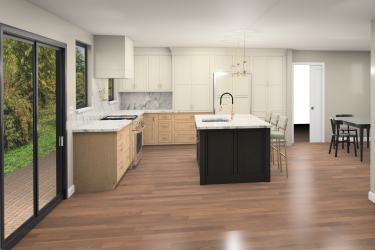Choosing the perfect countertop material is more than just a design decision; it’s a long-term investment in your home. The aesthetic appeal, durability, and ease of maintenance all contribute to the value and functionality of your kitchen or bathroom. One material that often goes overlooked in this selection process is soapstone. Known for its distinctive matte finish and unparalleled character, soapstone offers a unique blend of natural beauty and practicality.
In this blog post, we will delve deep into the world of soapstone countertops, focusing on their unique finish and how it stands apart from other materials like granite, quartz, or marble. From its natural aging process to its tactile experience, we’ll cover all you need to know to decide whether soapstone is the right choice for your remodeling project. So, whether you’re a homeowner looking for something distinct or a contractor aiming to expand your repertoire, read on to discover the wonderful world of soapstone.
The Natural Beauty of Soapstone
When it comes to selecting a countertop material, aesthetics often play a critical role, and soapstone does not disappoint in this regard. Unlike the polished and often shiny appearance of granite or quartz, soapstone features a natural, matte-like finish. The material is inherently elegant, giving your kitchen or bathroom an understated, yet sophisticated, vibe.
Soapstone is a metamorphic rock that’s primarily composed of talc, with varying amounts of chlorite, pyroxenes, micas, amphiboles, carbonates, and other minerals. The composition, look, and characteristics of soapstone can vary depending on where it’s sourced from. However, it’s important to note that not all soapstones are suitable for countertops; some are better suited for artistic or industrial purposes. Here’s a general overview of the different types of soapstones and their characteristics:
1. Artistic Soapstone
- Composition: High talc content
- Characteristics: Very soft, easy to carve, and usually not suitable for countertops.
- Color: Lighter shades like white and pale green.
- Usage: Primarily for sculptures, carvings, and smaller artistic projects.
2. Architectural Soapstone
- Composition: Lower talc content compared to artistic soapstone, higher percentages of other minerals.
- Characteristics: Harder and denser, making it suitable for architectural applications like countertops, sinks, and tiles.
- Color: Typically shades of gray, green, or blue, often with subtle veining.
- Usage: Countertops, sinks, flooring, and fireplaces.
Subtypes of Architectural Soapstone:
- Green Soapstone
- Color: Dark green shades
- Veining: White or lighter green
- Characteristics: Sturdy and dense, good for countertops.
- Black Soapstone
- Color: Charcoal to black
- Veining: White or gray
- Characteristics: Dark and elegant, may scratch more easily than lighter types.
- Gray Soapstone
- Color: Various shades of gray
- Veining: Light gray or white
- Characteristics: Versatile in design, widely used for countertops.
- Blue Soapstone
- Color: Blueish-gray
- Veining: Light blue or white
- Characteristics: Unique and striking, slightly less common.
3. Paired Soapstone
- Composition: Architectural soapstone paired with other materials like quartz or granite.
- Characteristics: Combines the benefits and aesthetics of both materials.
- Usage: Specialized architectural applications, often as accents or features rather than primary surfaces.
4. Brazilian Soapstone
- Composition: Similar to architectural soapstone but sourced from Brazil.
- Characteristics: Known for rich veining and deep colors.
- Usage: Countertops and high-end architectural projects.
5. Indian Soapstone
- Composition: Similar to architectural soapstone but sourced from India.
- Characteristics: Tends to be harder and has different veining patterns.
- Usage: Countertops, tiles, and architectural elements.
Note that each specific quarry will produce soapstone with unique characteristics, so even within these broad categories, there can be variations in color, veining, and other attributes.
For your kitchen and bath design and remodeling business, offering a variety of soapstone types can give your clients more options to match their design aesthetics and functional needs.
Color Variations
One of the most appealing aspects of soapstone is its color palette. Generally, soapstone comes in varying shades of gray. Some varieties offer subtle veining or hints of white marbling, providing a pleasing contrast. The color scheme makes it versatile enough to complement various design styles, whether you’re going for a rustic, modern, or traditional look.
The Ageless Character of Soapstone
Soapstone has a unique trait that homeowners either love or need to be prepared for—it darkens over time. Yes, this is a countertop material that actually evolves as it ages, taking on a deeper and richer color. This is not considered a flaw but rather one of the stone’s most charming attributes.
Natural Aging Process
The darkening process is gradual and natural. The soapstone will move from its original lighter gray to shades of deeper gray, and sometimes even to a charcoal or almost black hue. Many homeowners appreciate this living aspect of the material, as it adds character and a sense of history to their space.
A Living Surface
The transformation of soapstone can make your countertops look like a different material five or ten years down the line. It’s akin to having a living, breathing piece of nature right in your home, one that bears witness to countless family gatherings, meal preps, and daily routines.
To Oil or Not to Oil: Enhancing Soapstone's Aesthetics
While the natural finish of soapstone is appealing to many, some homeowners opt to accelerate or emphasize its color and veining by applying mineral oil or special soapstone wax. But rest assured, this treatment is optional and primarily an aesthetic choice.
Mineral Oil or Soapstone Wax
A light application of mineral oil can make the natural veins in the soapstone more prominent, giving your countertop a more dynamic look. Alternatively, soapstone wax serves a similar purpose but may last longer between applications.
The Choice is Yours
Whether or not to treat your soapstone with oil or wax depends on your personal preference for its appearance. Some prefer the natural, untouched aesthetic, while others enjoy the enhanced look that oiling or waxing provides.
Durability and Maintenance: What to Expect
Although soapstone is softer than materials like granite or quartz, it has its own set of advantages when it comes to durability and maintenance.
Resistance to Scratches and Nicks
While soapstone is more susceptible to scratching and nicks, these minor damages are often easily remedied. A simple sanding process can usually remove these imperfections, maintaining the countertop’s beauty.
Heat Resistance
One significant advantage of soapstone is its exceptional heat resistance. You can place hot pots and pans directly on the surface without worrying about heat marks or damage.
Health and Safety: The Non-porous Advantage
The non-porous nature of soapstone makes it an excellent choice for both kitchens and bathrooms.
Hygienic Surface
Being non-porous means that soapstone won’t absorb liquids or harbor bacteria, making it a hygienic choice for food preparation and personal care spaces.
Stain Resistance
Unlike marble, which can be prone to staining from acidic substances like lemon juice or vinegar, soapstone resists staining due to its non-porous characteristics.
Soapstone in Design: Where It Fits Best
Soapstone is a versatile material that suits a range of design styles.
Ideal Design Themes
Whether you’re crafting a modern, rustic, or traditional space, soapstone can complement your design. Its natural, organic feel makes it particularly well-suited for heritage homes or eco-friendly designs.
Pros and Cons: A Balanced View
To sum up, here are the main advantages and disadvantages of choosing soapstone countertops:
Pros
- Natural, matte finish
- Aging adds character
- Non-porous and hygienic
- Heat resistant
Cons
- Softer, can be prone to scratches
- May require occasional maintenance (optional)
Conclusion
Soapstone countertops offer a unique blend of natural beauty, functionality, and evolving character. Whether you love the idea of a surface that ages alongside you or you’re drawn to its aesthetic and practical features, soapstone is an option worth considering for your next kitchen or bathroom remodel.






